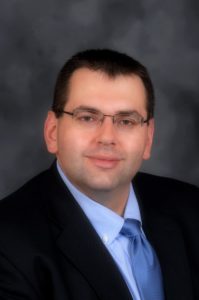This is part of a series of Session Notes from grantees who have received Professional Development grants from the Office of Commonwealth Libraries. Each grantee will share their professional development experience and include tips and other resources from the workshop or class. Grantees had their choice of an article for the Compendium, a webinar or a podcast. This project was made possible by the Institute of Museum and Library Services.
by Richard C. Miller,
Executive Director
Osterhout Free Library
Attending the Computers in Libraries Conference has long been a goal of mine. The award of a professional development grant allowed me to participate in the 2017 conference. Held just outside Washington D.C., the Computers in Libraries Conference definitely lived up to my expectations.
Computers in Libraries is very reminiscent of similar national conferences with people from all over the county, as well as international visitors, attending and learning from one another. The interaction and networking of these events is always a highlight since I learn a great deal from my peers. I spoke with people from gigantic libraries with budgets to match. I commiserated with other directors that always seem to have more needs than resources and even had a fascinating conversation with the administrator of a small national library network.
Throughout my time at the conference, my interactions with others will always be one of the most rewarding takeaways. At times I was fascinated, envious, curious, and even a little annoyed. What always impressed me was the fact that we share the same basic goals to bring people and informational resources together so that our communities may learn and experience the enrichment that only libraries can provide. We know that all types of libraries are here to build up and improve our communities. In this instance, everyone was focused on doing that through technology.
As for the conference itself, it was simply overwhelming, but in a good way. There were a bounty of sessions and activities to choose from. Each day included a series of programs in five different tracks along with keynotes, time to network, exhibits, and more. The tracks varied but were built around themes like Content management, Tech tools, Community engagement, Learning from leaders, and Internet @ schools. Since there was so much to choose from, I could not stay in one track and jumped around according to my interest.
Like any conference, some programs were exactly as promised, some were less stellar than the description, and there are always a few pleasant surprises that exceed expectations. To be honest, some programs were clearly a letdown early on so I jumped to my second choice. Overall, the programs I attended were excellent and I learned a great deal. It was difficult but I chose three of my favorite programs to share here.
My first choice was Innovation & Empowering Staff with presenter Gina Millsap. Ms. Millsap is the CEO of Topeka Shawnee County Public Library which was named Library of the year by Library Journal. In her talk, Millsap explained that the common concept of innovation is not necessarily correct. Instead of being something completely new, innovation is really about improving what already exists and finding new ways of doing things. Sometimes innovations are not new to us but it may be new to the customer. Millsap cited automatic renewals as an example.
A few of the others topics to foster innovation and empower staff included creating a culture of learning, set high performance expectations, make the library a learning organization, and commit to being the best. Millsap spent time explaining why it is so important to invest in our employees, not only in terms of salary but also to communicate and encourage them to see their community and customers. Several examples centered about the idea of getting out of the library and organize around the real world. There was much more to the presentation but I will close with her suggestion to embrace the Big Hairy Audacious Goal (BHAG). The BHAG is a long-term goal that has tremendous impact and changes the nature of the organization’s existence.
On Thursday, I attended one of the more fun presentations. Although it was not a crowded session, Library Story in Video, was enjoyable and the group seemed to feed off the energy of the speaker. The presentation started with Jennifer Burke saying “We all love stories. We’re wired that way. Everyone has a story. Every organization has a story. Every LIBRARY has a story. Usually many stories.” I instantly thought to myself, yes we do, we really do! Some of them are even fit to tell in public and may help people understand what we do and why it is so important. Others, like the bee sting lady that accidentally stabbed the scout troop leader with her allergy pen are best left for the after session sessions.
In all seriousness, this was an enjoyable program that was not only fun but educational. Jennifer prepared us to do a better job telling our library stories through video and examples of how best to make quality presentations. Anyone interested in seeing her tips can easily find them on the CIL website. My library has begun some forays into this type of project. It’s not as difficult as most people think and it’s never as professional as a Hollywood blockbuster but we all have important stories to tell.
My final example was Innovation on a Shoestring. Presenters were Dominique China from Brampton Library and Donna Bachowski from Orange County Library System in Florida. One of the reasons that I enjoyed this presentation is that it reminded me very much of our own PA Forward program. They began with a website that was titled “The Right Service at the Right Time” and included topics such as financial, healthcare, and jobs help. Yes very familiar to our own work in Pennsylvania. They discussed creating and hosting their own websites and databases to address the needs of their users not a generic prepackaged and overpriced service that is often sold to the library community.
Once again, the presenters focused on internal change and creating a culture that embraces innovation. In their experience, they had to shift 150 employees to feel empowered and take ownership of the electronic resources offered by the library. They explained the development of their own maker spaces and how they continue to evaluate e-resources. As far as planning for technology, always be prepared because it is changing. Design and acquire for the present but keep an eye on the future and plan for that!
The examples I mentioned are just a few of the highlights that I took away from the conference. Marketing, robotics, Artificial Intelligent, great keynotes, and so much more were packed into a few days. Every aspect of the conference held value for me and I thoroughly enjoyed the opportunity to expand my knowledge. Hopefully I will continue to refer back to what I have learned and to use that as my library and library system seeks to enrich our community. Access this year’s programs and check out the Computers in Libraries website for 2017.


